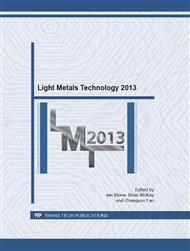[1]
N. Stanford, M.R. Barnett, Fine grained AZ31 produced by conventional thermo-mechanical processing, J. Alloy. Compd. 466 (2008) 182–88.
DOI: 10.1016/j.jallcom.2007.11.082
Google Scholar
[2]
M.R. Barnett, N. Stanford, P. Cizek, A. Beer, Z. Xuebin, Z. Keshavarz, Mechanism of deformation in magnesium alloys and the challenge of extending room temperature plasticity, JOM 61 (2009) 19–24.
DOI: 10.1007/s11837-009-0115-6
Google Scholar
[3]
M. Ferry, Direct strip casting of metals and alloys, Woodhead Publishing Ltd., Cambridge, 2006.
Google Scholar
[4]
Z. Bian, I. Bayandorian, Z. Fan, Extremely fine and uniform microstructure of magnesium AZ91D alloy sheets produced by melt conditioned twin roll casting, Mater. Sci. Technol. 25 (2009) 599-606.
DOI: 10.1179/174328408x326129
Google Scholar
[5]
W. Xia, Z. Chen, D. Chen, S. Zhu, Microstructure and mechanical properties of AZ31 magnesium alloy sheets produced by differential speed rolling, J. Mater. Process. Tech. 209 (2009) 26-31.
DOI: 10.1016/j.jmatprotec.2008.01.045
Google Scholar
[6]
S.B. Kang, J. Cho, L. Chang, Y. Wang, Influence of twin roll casting and differential speed rolling on microstructure and tensile properties in magnesium alloy sheets, Procedia Engineering 10 (2011) 1190-1195.
DOI: 10.1016/j.proeng.2011.04.198
Google Scholar
[7]
Y. Wang, S.B. Kang, J. Cho, Microstructure and mechanical properties of Mg-Al-Mn-Ca alloy sheet produced by twin roll casting and sequential warm rolling, J. Alloy. Compd. 509 (2011) 704-711.
DOI: 10.1016/j.jallcom.2010.07.183
Google Scholar
[8]
D. Liang, W. Borbidge, D.R. East, R.V. Allen: US Patent No.7,028,749 B2, 2006.
Google Scholar
[9]
Z. Fan, G. Liu, Solidification behaviour of AZ91D alloy under intensive forced convection in the RDC process, Acta Mater. 53 (2005) 4345–4357.
DOI: 10.1016/j.actamat.2005.05.033
Google Scholar
[10]
I. Bayandorian, Y. Huang, Z. Fan, S. Pawar, X. Zhou, G.E. Thompson, The impact of melt-conditioned twin-roll casting on the downstream processing of an AZ31 magnesium alloy, Metall. Mater. Trans. A 43 (2012) 1035-1047.
DOI: 10.1007/s11661-011-1006-3
Google Scholar
[11]
S. Das, N.S. Lim, J.B. Seol, H.W. Kim, C.G. Park, Effect of the rolling speed on microstructure and mechanical properties of aluminium-magnesium alloys prepared by twin roll casting, Materials and Design 31 (2010) 1633-1638.
DOI: 10.1016/j.matdes.2009.08.032
Google Scholar
[12]
Z. Fan, Y. Wang, M. Xia, S. Arumuganathar, Enhanced heterogeneous nucleation in AZ91D alloy by intensive melt shearing, Acta Mater. 57 (2009) 4891-4901.
DOI: 10.1016/j.actamat.2009.06.052
Google Scholar


